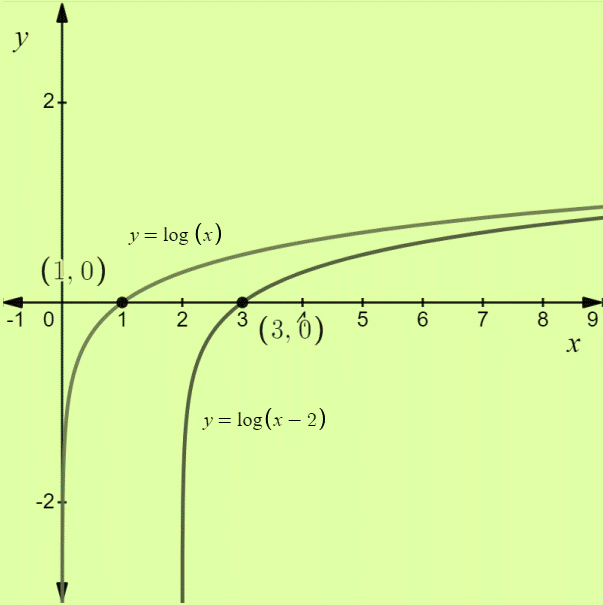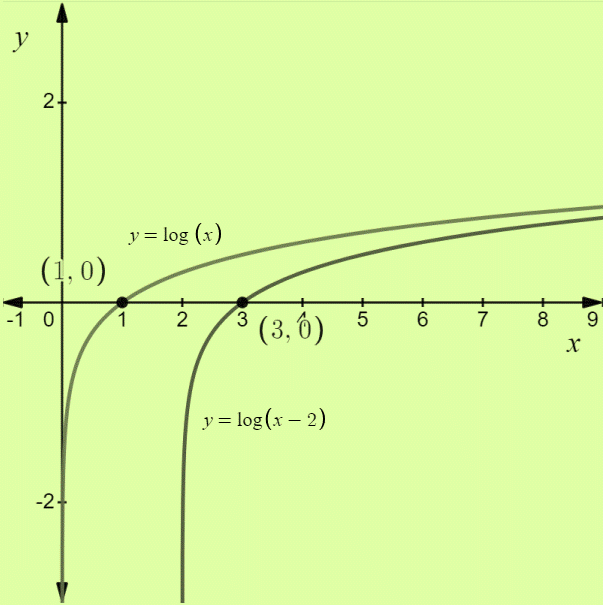
To graph: The given function and to analyze it.

The domain is
The range is
It is a continuous function.
Always increasing.
Not bounded.
No local extrema.
No symmetry.
No horizontal asymptotes.
The vertical asymptote is
End behavior:
Given:
Concept used:
The graph of
Calculation:
Start with the graph of
So, the graph of the given function is

The given function is well defined for all real numbers greater than 2, therefore the domain is
The range is
From the graph, it can be seen that the curve has no breaks or jumps; therefore it is a continuous function.
From the graph, it can be seen that the value of
Therefore, the function is always increasing.
The function is not bounded.
There are no turning points for the given curve, so there is no local extrema.
The curve is neither symmetric with the
So the curve has no symmetry.
There are no horizontal asymptotes.
The vertical asymptote is
End behavior:
From the graph, it can be seen that
Chapter 3 Solutions
PRECALCULUS:GRAPHICAL,...-NASTA ED.
- Two cables tied together at C are loaded as shown. Given: Q = 130 lb. 8 30° C B Q 3 4 Draw the free-body diagram needed to determine the range of values of P for which both cables remain taut.arrow_forwardCable AB is 103 ft long and the tension in the cable is 3900 lb. 56 ft A 50° 20° B x C Identify the angles 0.0, and 8, that define the direction of force. 1 By N 2 Match each of the options above to the items below. 142.1° 57.1° 73.3° 3 8.arrow_forwardIn the given figure, P = 51 lb . 65° C 25° 35° 75 lb P Determine the corresponding magnitude of the resultant. The corresponding magnitude of the resultant is| lb.arrow_forward
- Cable AB is 103 ft long and the tension in the cable is 3900 lb. 56 ft D y A B 20° 50° x C Identify the x, y, and z components of the force exerted by the cable on the anchor B. 1 F. FI 3 Fy 2 Match each of the options above to the items below. 2,120 lb 1,120 lb -3,076 lbarrow_forwardIn the given figure, P = 51 lb. 65° 25° 35° 75 lb P B Determine the required tension in cable AC, knowing that the resultant of the three forces exerted at point C of boom BC must be directed along BC. The required tension in cable AC is lb.arrow_forwardhelp on this question about Laplace transformation?arrow_forward
- Help me expand this fraction below.arrow_forwarddetermine the final and initial value of the expression below: Helparrow_forwardThe boom OA carries a load P and is supported by two cables as shown. Knowing that the tension in cable AB is 190 lb and that the resultant of the load P and of the forces exerted at A by the two cables must be directed along OA, determine the tension in cable AC. 29 in. B 24 in. 36 in. C 25 in. 48 in.. Aarrow_forward
- Find the distance (d) from the point (8, -7, -1) to the plane 3x+5y-3z = -60.arrow_forwardThe 60-lb collar A can slide on a frictionless vertical rod and is connected as shown to a 65-lb counterweight C. Draw the free-body diagram of the collar that is needed to determine the value of h for which the system is in equilibrium. -15 in. A 60 lb B C h 65 lbarrow_forwardTwo cables tied together at Care loaded as shown. Given: Q = 130 lb. 30° C B Determine the range of values of P for which both cables remain taut. lbarrow_forwardarrow_back_iosSEE MORE QUESTIONSarrow_forward_ios
 Calculus: Early TranscendentalsCalculusISBN:9781285741550Author:James StewartPublisher:Cengage Learning
Calculus: Early TranscendentalsCalculusISBN:9781285741550Author:James StewartPublisher:Cengage Learning Thomas' Calculus (14th Edition)CalculusISBN:9780134438986Author:Joel R. Hass, Christopher E. Heil, Maurice D. WeirPublisher:PEARSON
Thomas' Calculus (14th Edition)CalculusISBN:9780134438986Author:Joel R. Hass, Christopher E. Heil, Maurice D. WeirPublisher:PEARSON Calculus: Early Transcendentals (3rd Edition)CalculusISBN:9780134763644Author:William L. Briggs, Lyle Cochran, Bernard Gillett, Eric SchulzPublisher:PEARSON
Calculus: Early Transcendentals (3rd Edition)CalculusISBN:9780134763644Author:William L. Briggs, Lyle Cochran, Bernard Gillett, Eric SchulzPublisher:PEARSON Calculus: Early TranscendentalsCalculusISBN:9781319050740Author:Jon Rogawski, Colin Adams, Robert FranzosaPublisher:W. H. Freeman
Calculus: Early TranscendentalsCalculusISBN:9781319050740Author:Jon Rogawski, Colin Adams, Robert FranzosaPublisher:W. H. Freeman
 Calculus: Early Transcendental FunctionsCalculusISBN:9781337552516Author:Ron Larson, Bruce H. EdwardsPublisher:Cengage Learning
Calculus: Early Transcendental FunctionsCalculusISBN:9781337552516Author:Ron Larson, Bruce H. EdwardsPublisher:Cengage Learning





